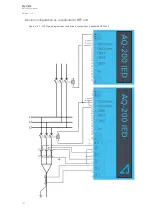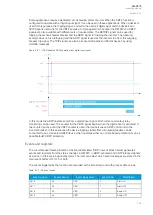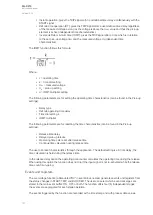
Event number
Event channel
Event block name
Event code
Description
2820
44
CBF1
4
CBFP ON
2821
44
CBF1
5
CBFP OFF
2822
44
CBF1
6
Block ON
2823
44
CBF1
7
Block OFF
2824
44
CBF1
8
DO monitor ON
2825
44
CBF1
9
DO monitor OFF
2826
44
CBF1
10
Signal ON
2827
44
CBF1
11
Signal OFF
2828
44
CBF1
12
Phase current ON
2829
44
CBF1
13
Phase current OFF
2830
44
CBF1
14
Res current ON
2831
44
CBF1
15
Res current OFF
The function registers its operation into the last twelve (12) time-stamped registers. The register of the
function records the ON event process data for ACTIVATED, BLOCKED, etc. The table below
presents the structure of the function's register content.
Table. 5.3.7 - 90. Register content.
Date and
time
Event code
Trigger
current
Time to
RETRact
Time to
CBFPact
F type
S type Used SG
dd.mm.yyyy
hh:mm:ss.mss 2816-2831 Descr.
Phase and
residual currents
on trigger time
Time
remaining
before RETR
is active
Time
remaining
before CBFP
is active
Monitored
current
status
code
Activate
start
triggers
Setting
group 1...8
active
5.3.8 Overvoltage protection (U>; 59)
The overvoltage function is used for instant and time-delayed overvoltage protection. Each relay with a
voltage protection module has four (4) available stages of the function (U>, U>>, U>>>, U>>>>). The
function constantly measures phase voltage magnitudes or line-to-line magnitudes. Overvoltage
protection is based on line-to-line RMS voltage or to line-to-neutral RMS voltage (as the user selects). If
the protection is based on line-to-line voltage, overvoltage protection is not affected by earth faults in
isolated or compensated networks. The blocking signal and the setting group selection control the
operating characteristics of the function during normal operation, i.e. the user or user-defined logic can
change function parameters while the function is running.
The outputs of the function are the START, TRIP and BLOCKED signals. The overvoltage function
uses a total of eight (8) separate setting groups which can be selected from one common source.
The function can operate on instant or time-delayed mode. In time-delayed mode the operation can be
selected between definite time (DT) mode and inverse definite minimum time (IDMT).
The operational logic consists of the following:
• input magnitude selection
• input magnitude processing
• threshold comparator
• block signal check
• time delay characteristics
• output processing.
A
AQ
Q-C213
-C213
Instruction manual
Version: 2.04
143
Содержание AQ-C213
Страница 1: ...AQ C213 Capacitor bank protection IED Instruction manual ...
Страница 308: ...Figure 7 4 184 Example block scheme A AQ Q C213 C213 Instruction manual Version 2 04 307 ...
Страница 330: ...Figure 8 14 207 Panel cutout dimensions and device spacing A AQ Q C213 C213 Instruction manual Version 2 04 329 ...
















































